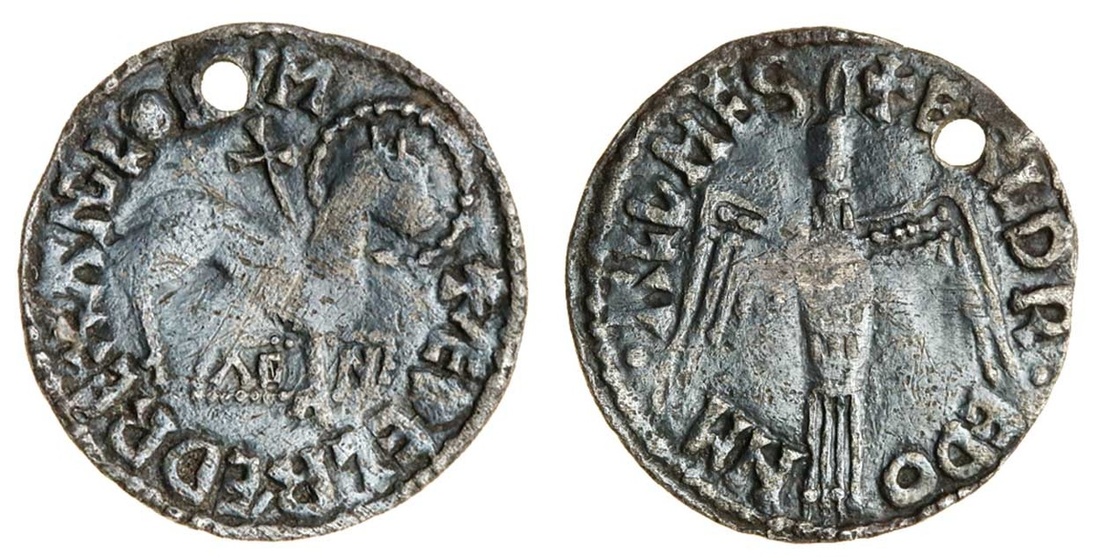
Auction: 18012 - The Williams Collection Part II, Anglo-Saxon and Viking Coins
Lot: 179
(x) Aethelred II (978-1016), Penny, 1.53g, Agnus Dei type, Malmesbury, Ealdred, +
Bruun Rasmusson auction 816, 4 December 2010, lot 5316
From the Emil Gjerløff (1858-1932) collection
Probably found in Denmark
R.H.M. Dolley, 'The Nummular Brooch from Sulgrave', in England before the Conquest, eds. Clemoes and Hughes, 1971
M.K. Lawson, 'Archbishop Wulfstan and the Homiletic Element in the Laws of Aethelred II and Cnut', in The Reign of Cnut, ed. A. Rumble, 1994
Keynes and Naismith, 'The
The most recent review of the Agnus Dei coins of Aethelred is Simon Keynes and Rory Naismith, 'The Agnus Dei pennies of King Aethelred the Unready', in Anglo-Saxon England, vol. 40 (2011), pp. 175-223. This includes an illustrated listing of the 21 known examples. There are four coins by the moneyer Ealdred at Malmesbury (this coin is no. 4), struck from one pair of dies. Of the other three, one is in the British Museum, the second is in the Royal Coin Cabinet, Stockholm, and the third is in a private collection in the U.S.A.
The last Agnus Dei Penny offered at auction in London was a recent find from the south of England sold in Spink auction 124, 18-19 November 1997, lot 2197, for a total of £9,680. The footnote written at that time has in general not been contradicted by recent surveys, though six specimens, including this example, have since been added to the corpus of known coins.
'The
The extreme rarity of the issue, certainly in comparison to the other issues of the reign, had long been linked to the idea that the isue was a substantive type that was abruptly aborted. However, the issued dies in one area, West Mercia, were used for a short period prior to being withdrawn. The impetus for the issue is difficult to pin-point in the turmoil of Aethelred's reign and against a background of near constant Viking raids, but the strong religious imagery does provide clues.
One theory that gained widescale acceptance was an association of the design with contemporary fears about the approaching millenium. The Lamb was interpreted as alluding to the Lamb of the Apocalypse in the Book of Revelations. Michael Dolley has however shown that the Agnus Dei was most probably minted in 1009 and as M.K. Lawson has further illustrated can probably be associated with a meeting at Enham, Hampshire at Pentecost of that year, where the decision to introduce the Agnus Dei was taken. The Mass for Pentecost Sunday was celebrated by Archbishop Wulfstan, and can be seen as a occasion for him to preach to a large congregation at a time of acute national distress. The Lamb and the Holy Dove would have been extremely evocative symbols at a meeting of this nature, Enham evidently meaning "the place where lambs are bred". Wulfstan's frequent use of the pen-name Lupus-Wolf and its associations with the concept of the shepherd, lamb, and wolf, are a coincidence that it would be as foolish to ignore as to over-emphasize. The Holy Dove alludes to the Holy Spirit which descended onto the Apostles at the first Pentecost. The Lamb of God has many possible symbolic meanings, peace, a parallel to Christ taking up the cross but most importantly as Michael Dolley noted, in reflecting a change in the Liturgy of the Mass at this date, in which the third invocation addressed to the Lamb is changed from miserere nobis to dona nobis pacem.'
A further aspect of this remarkable coinage is that these coins seem to have had an influence on Scandinavian coinage which is out of all proportion to the tiny number of surviving examples. Of the 21 coins now known, only two (and possibly a third) have been found in England. For two others the find spots are uncertain, though one of these has peck marks, suggesting at least a period of circulation in a Viking context. The other sixteen coins have all been found in Scandinavia and the Baltic region, twelve in hoards, three as single finds, and our coin, from a Danish collection formed before 1932, for which the exact circumstances of the find, traditionally said to have been in Denmark, are unknown. In additon there are two mules, one Agnus Dei / Last Small Cross mule in the Royal Coin Cabinet, Stockholm (Hildebrand 3445), that was found in Gotland, and the recently discovered (December 2014) second Agnus Dei / Last Small Cross mule from the Lenborough hoard, now in the Fitzwilliam Museum. Further, as Keynes and Naismith point out, ten of these have been pierced, and some of them have rings or loops still intact. While piercing of Pennies is not unusual, the high proportion of these coins that have been used as jewellry is notable. Finally it is worth mentioning that the Agnus Dei type was imitated in both Sweden and Denmark, struck at the mints of Sigtuna and Lund. See lots.... in the present sale.
Subject to 5% tax on Hammer Price in addition to 20% VAT on Buyer’s Premium. For more information please view Terms and Conditions for Buyers.
Sold for
£18,000




